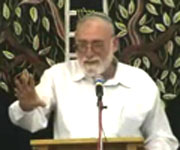Beit Midrash
- Sections
- Chemdat Yamim
- Parashat Hashavua
- Torah Portion and Tanach
- Bereshit
- Vayigash
Questions having to do with service in the IDF come up all the time. We will mention that our mentor, Harav Shaul Yisraeli z.t.l., determined that only those who did their duty by serving in the IDF can be accepted as fellows at Eretz Hemdah. Let us take a look this time not at who must serve but who is fit to serve. Must one be of unblemished Jewish heritage? We will investigate the matter in Nach and the writings of Chazal, Rishonim, and Acharonim.
The Books of Shmuel and Divrei Hayamim give attention to the great warriors of David’s army. We find Achimelech the Chitite serving as a counterpart to David’s nephew and general, Avishai ben Tzruya (Shmuel I, 26:6), while Shaul was still alive. So even at that early stage, David had a Chitite among his trusted men. It is possible that Achimelech was an Israelite who lived in the Land of Chet. But it is difficult to make that claim here considering how far the Land of Chet (southern Turkey) is from Judea, where David was operating. It is true that there were Chitites in Chevron at the time of Avraham, but Chazal do not raise such an explanation in regard to Achimelech.
Another famous "Chitite" in David’s army was Uriya (Batsheva’s husband), who fought against the Amonim (Shmuel II, 11-12). He is listed as a prominent officer (Divrei Hayamim I, 11:41). In the latter source, we learn also of Tzelek the Amoni. One can ask the same questions about them. Another prominent officer was Itai of Gat. Gat was the city of Achish, a Plishti king who was a patron of David during part of the time of David’s fleeing Shaul. Achish was a great admirer of David, referring to him as "you are good in my eyes like an angel of G-d" (Shmuel I, 29:9). When David was fleeing Avshalom, Itai came leading 600 men of Gat who "came with his leg" (Shmuel II, 15:18-19). David asked him why he felt a need to come, as he was a foreigner who was in exile (ibid. 19). The term "came with his leg" is a reference to the fact that he left Gat in the past to join David’s army (see Radak ad loc.). So we have evidence that 600 soldiers of Plishti origin joined David at some point during his Kingdom.
Next week we will continue to develop this point, including factoring in the possibility of conversion. In the meantime, we pray for the welfare of the present day soldiers of IDF.

Parashat Hashavua: “All Creation Will Know” – part IV
Rabbi Yossef Carmel | Elul 5785

Giving More Than You Have?
Rabbi Yossef Carmel | 20 Cheshvan 5767

Parashat Hashavua: Can One Give a Loan to Hashem? – part I
Rabbi Yossef Carmel | Elul 5785



















